Gold Architecture Throughout The World
Gold Architecture Throughout The World
Gold is unarguably a valued commodity by people all over the world. Considered a safe haven for investors, gold bullion bars and coins fill vaults worldwide as people seek to protect, as well as expand, their wealth. But how did it become so? What makes this precious and shiny yellow metal so prized compared to other metals and commodities?
There are many factors that contribute to gold’s iconic status, as jewellery, as decorative art pieces and more – holding such a high status among societies and, ultimately, their economies. To better understand gold’s place in the world, we will explore some fundamentals as well as discuss gold’s role in civilizations through the ages.
Specifically, we will look at the use of gold architecture in various countries across the globe. As a precious metal and commodity, what is it about gold that inspired architects, designers, and engineers to use it for major, significant structures?
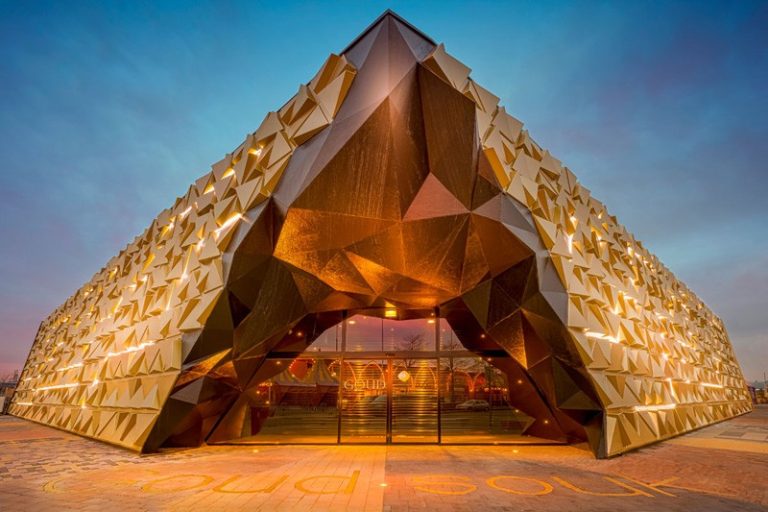
The Gold Souk, The Netherlands
Why is gold valuable?
A major driver for a commodity’s value is its scarcity, and gold is a rare find. While copper comprises 55 parts per million (ppm) of the Earth’s crust, gold measures in at just 0.0038 ppm. However, we could argue that scarcity just enhances gold’s other distinctive qualities. Gold is very malleable and ductile. This means it can be easily shaped, even into thin wires and gold leaf. A spinner could produce over 1,200 miles of gold wire from a single ounce of gold sheet just 0.1 microns thick.
Although it is so pliant, it is still very durable. Gold has an extremely high melting and boiling point, so it maintains form under heat. And, as a noble metal, it does not degrade through oxidation (rust or tarnish), and it will only corrode if exposed to strong acids. Also, gold’s brilliant shine is attractive. So, we can see the appeal as museums and collections around the world feature gold artefacts that still maintain their beauty after hundreds, if not thousands of years.
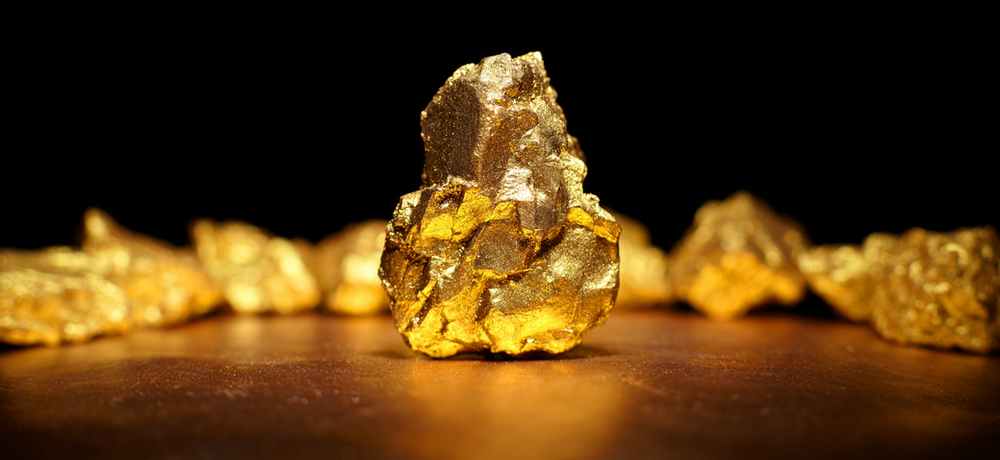
Gold as symbol of the divine and of power
With these constants that are not found in other metals, along with its rarity, it is understandable that civilizations have ordained gold with reverence. Known as the sweat or tears of the gods by the Incas and the flesh of the gods by the Egyptians, we can see how many ancient civilizations appreciated gold’s unique enduring qualities. With that, gold developed into a symbol and material solely for religion and royalty. And how better to showcase your devotion or your status than with a building made of gold?
Gold in historic buildings
You may ask why would anyone build a structure out of gold? Gold is not an ideal building material since it is expensive, and because it is so malleable, it would not be good for supporting a heavy building. This is why you will see gold as a decorative touch or covering a sturdier material as gold leaf.
Gold leaf allowed designers to show off a building’s opulence while also protecting it. That thin sheet can often last longer than paint, although at today’s prices it may be more cost-effective to repaint! Here are a few historic buildings from around the world that used gold to great effect:

Shwedagon Pagoda, Myanmar (above)
Revered as one of the world’s oldest Buddhist stupas, Shwedagon Pagoda is known for its many reliquaries, including strands of the Buddha’s hair, as well as the thousands of gold plates as well as thousands of diamonds, emeralds, and rubies that decorate this 2,500-year-old architectural wonder.
Sree Padmanabhaswamy Temple, India
Many believe that this temple is around 5,000 years old, with writings describing a city and temple made of gold. Gold covers the entire building and has six vaults filled with statues, weapons, and other artefacts made of solid gold. These were apparently part of offerings donated to the temple by princes for various rituals to please the god Vishnu, who was said to live in the temple.
Catherine Palace, Russia
While the pagoda and temple stood the test of time, Catherine Palace, outside St. Petersburg, did not. The famous Amber Room had walls decorated with amber on gold leaf, while the exteriors were covered in gold leaf and statues comprising 100 kg of gold. At the end of World War II, the Germans set fire to the palace, destroying almost the entire structure, but a restoration effort that began in 1957 allows visitors a glimpse of the golden opulence centuries ago.
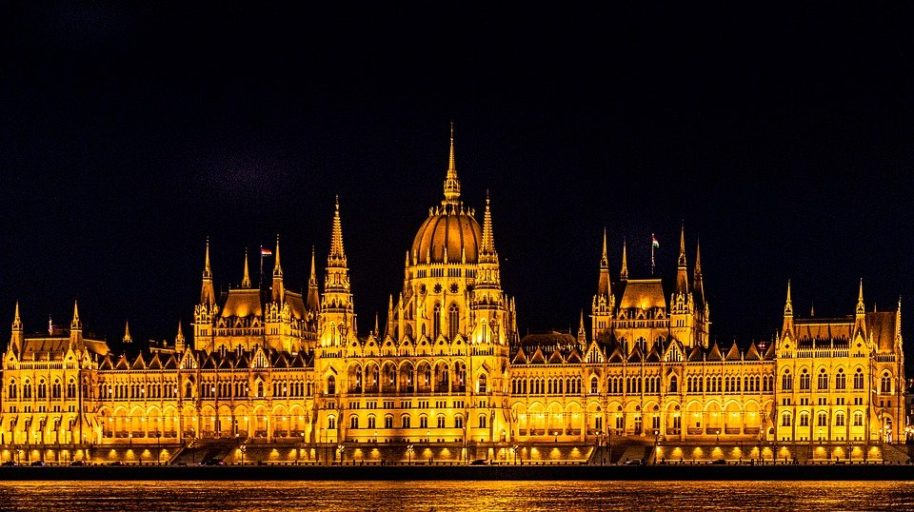
Parliament Building, Hungary (above)
The other buildings listed here are homages to religion and royalty, but this building celebrates the sovereignty of representative government. Built at the turn of the 20th century, the Hungary’s Parliament Building overlooks the Danube River and gleams from the thousands of precious stones and 40 kg of gold in baroque, Gothic, and Renaissance structures, decorations, including statues and coats of arms.
La Iglesia de la Compañía de Jesús, Ecuador
With construction beginning in 1605 and finishing over 150 years later, to call the Iglesia de la Compañía de Jesús de Quito just a church seems like an understatement. Almost every inch of this Jesuit church is intricately carved and covered in gold leaf, totaling almost two tons of gold.
Gold architecture in modern buildings
Using gold architecture and gold leaf in modern buildings is not as common as it was over the past centuries, there are many iconic structures that feature gold as its primary color and inspiration. Although a few did splurge on incorporating the precious metal. Here are a few of our favorites:
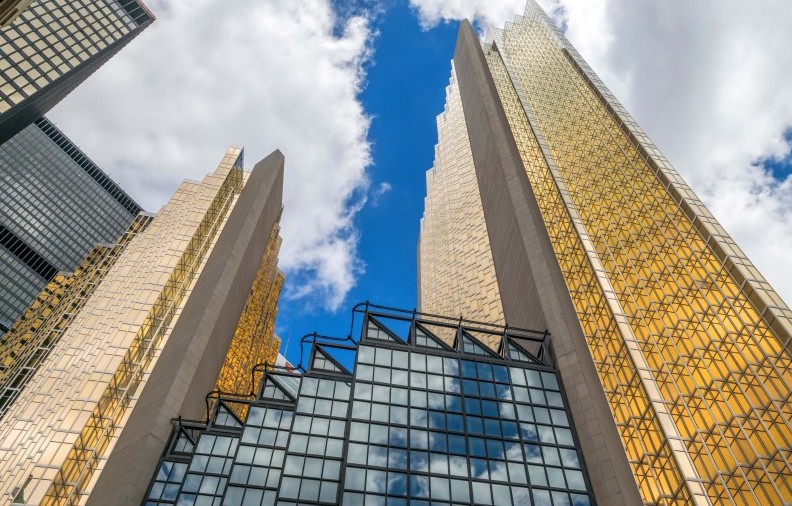
The Royal Bank Plaza, Canada (above)
It would make sense that the country’s Royal Bank’s headquarters be housed in golden towers with beautiful gold architecture. But this building did make the extra effort to coat its windows with a layer of 24-karat gold. At around $70 a window for a total of about $1 million, this may seem extravagant, but the gold makes superb insulation, lowering heating costs.
Department Archives of Rhone, France
This government archive holds a treasure trove in the form of information and historical documents. The exterior is made out of aluminum and copper alloyed panels, contrasting with black granite, creates the image of a simple treasure chest, so it seems fitting.
Auroville Matrimandir, India
Even those aspiring for “human unity” see gold as a treasure. This geodesic dome gleams as a center to this open community founded in India in the 1960s. Over 1,400 stainless steel discs from 1.5 to 2.3 meters, covered in gold leaf, interlock to create this structure that is used by the community as a meditation hall.
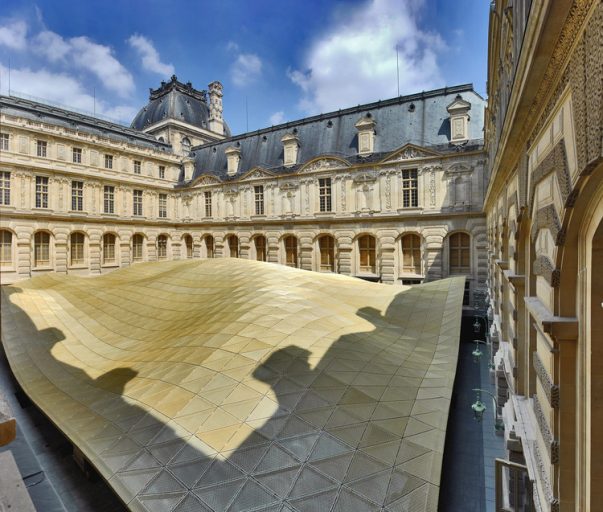
Department of Islamic Art at the Louvre (Above)
Glass and steel covered with gold-toned aluminum creates the sense of a lush flying carpet or glittering sand dunes, depending on your point of view. However, this floating veil illuminates a spacious gallery with golden hues, highlighting the Louvre’s Islamic art collection. An amazing peice of gold architecture.
J. Rotbart & Co. values gold
These are just a few examples of how gold architecture has been used around the world, and throughout the ages, to accentuate or highlight a society’s or civilization’s dedication to a deity or concept through architecture. J. Rotbart & Co. joins in this celebration of gold as a precious commodity, ready to assist investors with their precious metals needs.

